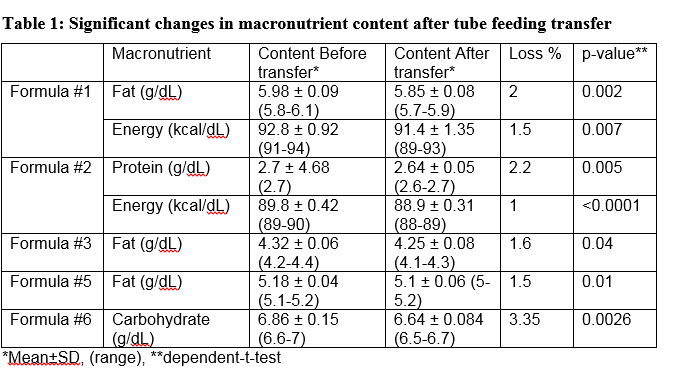Background: Providing appropriate nutrition for growth and development is a cornerstone in the
care of very low birth weight (VLBW) preterm infants.
Little is known about the impact of formulas passage through NGT on the macronutrient content.
The aim of our study was to evaluate changes in macronutrients content of various formulas after
transfer through a feeding tube.
Methods: Eleven frequently used formulas were chosen.
Included were 2 preterm formulas (#1 and 2), 4 extensively hydrolyzed formulas (#3-6),
2 amino acid based formulas (#7 and 8) and 3 standard cow’s milk based formulas for
term infants (#9-11).
Tube feeding was performed by using an infusion pump (Alaris™,CareFusion) connected to a
feeding tube to transfer 30 ml of formula at a speed of 30 ml/h.
Human Milk Analyzer was used to compare the pre-infusion and post-infusion macronutrients
contents of the different formulas.
Results: A total of 220 measurements were performed.
Variations in at least one macronutrient were observed in 5 out of 10 formulas.
In general, we observed a reduction of 0.05±0.09 g/dL in fat content after transfer through feeding tube (from 4.48±0.863 g/dL to 4.432±0.855 g/dL, p< 0.00001) which reflects a mean reduction of 1.1 % of fat content.
Fat and energy content were modified in one preterm formula (#1). Fat content was altered in two other extensively hydrolyzed formulas (#3 and #5) whereas carbohydrate content was affected in
the fourth extensively hydrolyzed formula (#6).
Protein and energy content were affected in the second preterm formula (#2) (Table 1).
Conclusion: Changes in the macronutrients content after tube feeding transfer were observed for
some infant formulas including those designed for VLBW infants.
These alterations might relate to specific formulation of each formula.
The biological significant of our results to the VLBW infant should be further studied.


